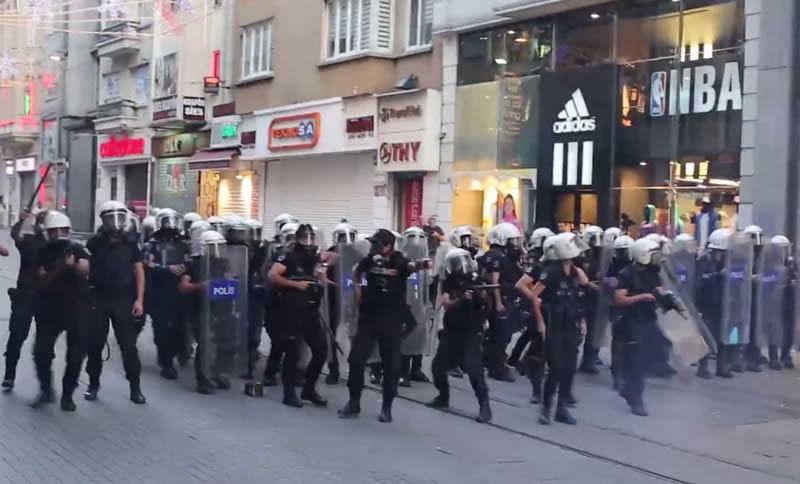In the early hours of Tuesday morning, September 10th, Ahmet Atakan (22 years old) died. He was hit by a tear gas canister to the head from 5m. away. After undergoing treatment in hospital, he died. The protest Ahmet attended was a solidarity demonstration in Antakya (the southernmost point of Turkey, sandwiched between Syria and the Mediterranean – also incidentally where the vast majority of Syrian refugees in Turkey are). This protest in Antakya was in response to the violent clashes that have taken place in Ankara for the last week, partly due to discrimination by Erdogan’s government against the Alevi minority (whose temples of worship are still not recognised by this Sunni government); and partly due to a vast road being built through the Middle Eastern Technical University campus in Ankara: again, just like Gezi, an environmentalist concern catalysing into something much bigger.
The situation in Antakya and Ankara is far more brutal: protesters coming to show their solidarity with Ahmet’s family were pepper sprayed at the hospital he died at, and the funeral itself was tear gassed as they marched through the streets. The Turkish police have released a video today showing an unidentified man falling from a tall building, and claiming that was how Ahmet died on Monday night. However, the autopsy and doctors who treated Ahmet as he fell into a coma claim that there are no signs that Ahmet fell off a building, nullifying the police’ position.
So in response to the sixth martyr of the Turkish resistance (there was also one policeman who died falling off a bridge while pursuing protesters back in June), protests were called all over Turkey and abroad (protests were also held across Europe). At 7pm, protesters were meant to congregate in Taksim square, but by 6.55pm the whole neighbourhood was in thick clouds of tear gas – the familiar sights began to reappear. The police were certainly showing their eagerness to live up to their reputation, an oppressive form of policing which they have developed to perfection over the last few months.
In terms of policing here in Turkey, there is a common misconception that they have been the same since the start of the protests – it’s important to recognise the shift which has taken place since the protests began. Of course, they’ve always been brutal, but they were never so willing to pursue protesters as they are now. They stuck to the main roads, firing gas down the residential side streets leading off the main street. They used more pepper spray on nearby cameramen, passers-by and less water-cannon. But the tactics have changed. They happily rampage down small streets into territory they wouldn’t have trodden before, making significant in-roads into previous çapulcu territory. Smaller vehicles have been brought in – commonly referred to as the “scorpions” due to their ability to drive down smaller streets unlike the bulky TOMA water cannons. These “scorpions” are essentially land-rovers with a hood on top where a policeman with a gun sits, much like a modern-day tank. Out of these guns, plastic and rubber bullets, along with the occasional deafening sound bomb, are fired. The echoing ‘tac tac’ of these guns have become an all too familiar sound on the streets of İstanbul.
So, essentially, what we see is a police force which is more trigger happy, mobile and oozing with confidence. They fear nobody and they’re far happier to be in the close vicinity of protesters and onlookers alike compared to before. In fact, they live off the fear of the protesters. This fear is something which has become more and more prominent. When the protests started, protesters felt no fear, they refused to retreat from the police, and they even managed to drive the police out and create a utopian free state in Taksim for 10 days. Now, protesters shy away from the first sound of shots, they don’t even dare be in the police’s line of vision, preferring to take comfort behind walls. Even the protester’s expression has shifted dramatically: before, powerful, fearless, determined and bursting with excitable energy; now, exhausted, weary, contemplative and downtrodden. There are very few happy protesters these days. They exist in the form of militant, barefooted Kurdish 7 year olds from the politically-sensitive district of Tarlabasi, nearby.
Protesters get chased down side streets, sometimes running away from these “scorpions” as they are being fired on. Before these side streets were the safe-havens, a place for protesters to catch their breath. But now, the police roam everywhere, nothing is beyond their reach. The bars of Istanbul alone continue to save countless protesters’ lives, always acting as a refuge for the injured, affected or just exhausted protesters needing to escape the tear gas fumes.
Yesterday I was standing in the doorway of one of these bars when I saw police firing tear gas, and one woman who was significantly older than the usual youthful protester, was severely affected by it. She immediately fainted and was quickly dragged by other protesters into the bar I was in, where she was given all the medical attention she needed. But it took her over 20 minutes to recover and when she did she came outside and vomited for about 5 minutes – CS gas is, after all, a non-lethal chemical weapon banned by the 1972 Geneva convention in a war setting (but inexplicably acceptable in a domestic riot control setting) which does fuck you up.
So what can these protesters do? As I stood there gaping at the scenes, I realised how this movement – originally peaceful to the core, exemplified by the famous photograph of the woman in red being pepper sprayed in Gezi Park – has become utterly powerlessness in passively resisting. The peaceful environmentalists of Gezi Park are long gone, so are the families, so who is left? The people who refuse to give in to the state’s violence, who continue to resist because protesters are still dying at the hands of the police. And these protesters aren’t necessarily violent, but in a way they’ve become violent by the simple fact that they don’t allow themselves to be driven away by the police. The state’s rhetoric is relatively simple: create violent scenes with their water, gas and bullets, and thus anyone who is in these ‘violent scenes’ is deemed violent and an enemy of the state.
Now to continue on this theme, even slogans themselves have become ‘violent’ in this way. At one point last night a group started chanting slogans such as ‘Everywhere is Taksim, Everywhere is Resistance’ or the new one which can be loosely translated as ‘Being a Simit-seller is more honourable than being a policeman’ [A Simit is a sesame-seed donut shaped bread which is the most popular snack in Turkey]. My immediate thought, along with everyone around me, was: Ah shit, now we’re going to be attacked. And that’s exactly what happened. Along with every other occasion where chants went up, the police crack down on this heavily, raining bullets, sometimes driving water cannons if the streets are accessible and always firing their trusty tear gas.
So something as passive as chanting leads directly to an escalation of the violence. If one doesn’t chant, you are destined to be a passer-by, watching with horror and feeling utterly powerless, a situation I have found myself in countless times. And then the distinction between protester and onlooker becomes very blurred, even though the onlookers are simply protesters who are too afraid to chant.
I woke up the following morning with my legs aching. The sheer energy your body consumes to be in such scenes for a few hours is incredible. Whenever I have throughout June and July, and again on Tuesday night, I’ve come home completely exhausted, both physically and mentally. I went to a friend’s house in the afternoon, and after consuming my fair share of çay, the conversation quickly moved on to the subject of the protests:
‘Were you out there last night?’ I asked
‘Yes’ she said with a look of complete exasperation, ‘But I didn’t stay for very long as I wanted to enjoy my night.’
I gave her a sympathetic look something akin to saying ‘I feel ya’.
‘There’s no point anymore, I was heavily involved before but I can’t bear it any more, I just want to be happy now.’
This is the kind of conversations I’ve been having with countless Turks over the last couple of months. People don’t see their place in the protests, simply because there is no room for peaceful protesters on the streets. What we have seen in Turkey is a perfect example of how oppression works, how it erodes all the issues into a vast amalgamation of violence. And the sad sad truth is that whilst Tuesday’s was probably the biggest protest since June (followed by more protests in Kadiköy in the following days), it cannot continue peacefully. It can’t. It simply isn’t possible to resist peacefully. Either it stops its street-based resistance or it turns violent. These protesters are not like Gandhi, there’s no energy to continually meet violence with passivity, perhaps partly explained by its grassroots, leaderless nature. The only way forward to respond to violence is violence. Before, there was the sanctuary of the park to peacefully resist. Now, there are only the streets. And the streets are violent.
Written by Yvo Fitzherbert
Yvo Fitzherbert studied history at the School of Oriental and African Studies in London before moving to Turkey where he teaches English in Istanbul.




